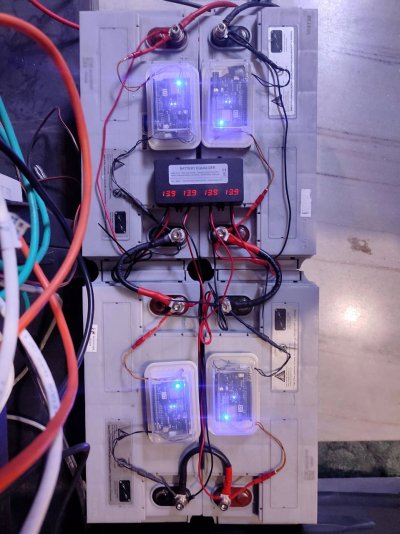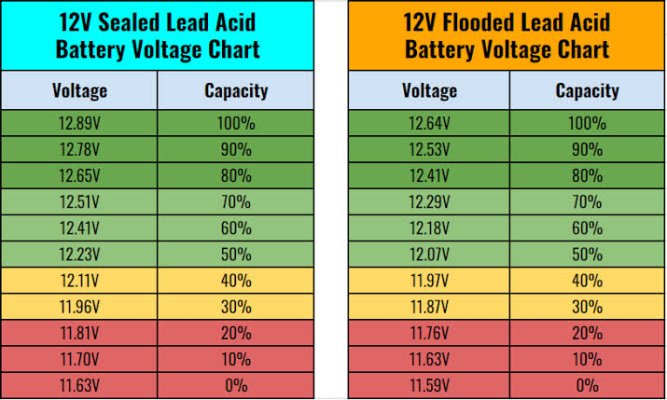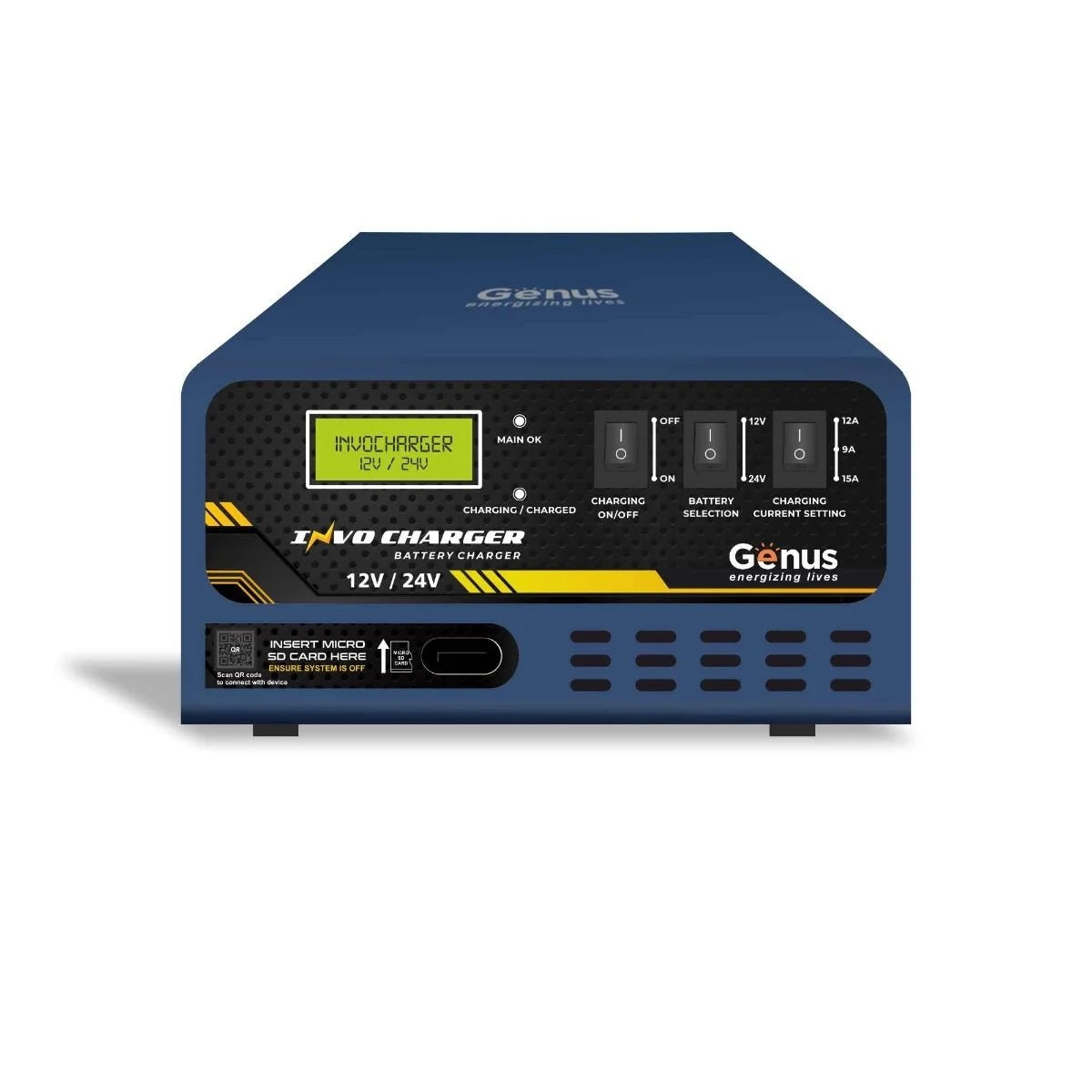rsaeon
Innovator
I'm going to consolidate my experiments and adventures with inverter batteries here.
Previous posts on the topic:
 techenclave.com
techenclave.com
 techenclave.com
techenclave.com
One of the earlier warning signs I noticed (and chose to ignore) when I first started trying to understand why my inverter batteries died so quickly (2.5 years) was this:
From: https://www.amaronbatteryinverterchennai.com/files/amaron/Quanta Silver Book.pdf
And from: https://amaronquanta.com/wp-content/uploads/2022/04/Amaron_OM_Manual.pdf
The inverter I'm using (Luminous Cruze+) floats the batteries at around 13.9V per battery, which sounds like it's a lot higher than what's recommended and may have been a reason why my batteries died so quickly.
The charging/float voltage on this inverter is not configurable and short of reverse engineering/modifying the controller board, I'm not left with any option other than to exchange my sealed batteries for flooded ones.
But I really like these batteries, so I spent several weeks searching the internet and found this somewhat relevant post/reply from twenty (!) years ago:
(To answer their original question, the calibration procedure is now well documented elsewhere and here: https://kirbah.github.io/apc-ups/)
It really sounds like they had a very similar problem to mine back then — high float voltage shortening the life of SMF batteries.
A reply stood out:
This made sense to me, the idea/practice of lowering the float voltage with a diode. So my searchings were renewed for a high power diode and I found these 40A and 70A rated diodes at mathaelectronics.com:
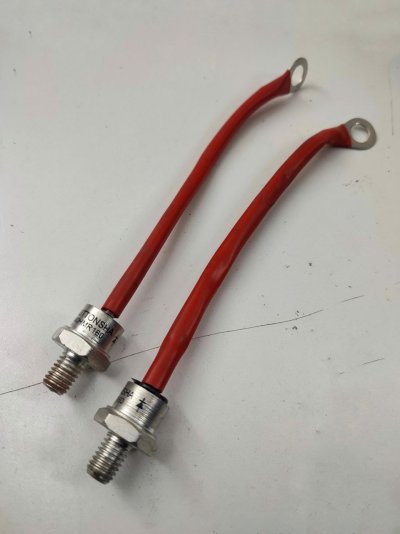
I got a few them and started thinking about how I'd want them wired up. I'd need them to be able to conduct electricity in both directions, so that the inverter can both drain and charge the batteries. And I'd want at least a 1.5V drop during float charge, so as to bring the +55V float voltage down to 54V. A single diode drops voltage by about 0.7V. I came up with this arrangement:
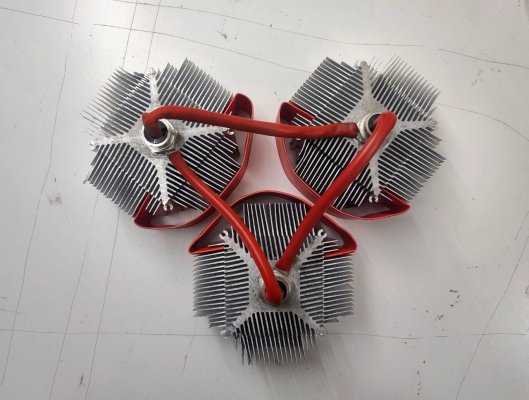
It looks pretty awesome haha, it's basically three diodes arranged in a circle. The idea is that the battery is connected to one diode on the top left, and the inverter to the diode on the top right. So electricity flows through one diode when the inverter is pulling power from the battery, and it flows through two diodes when it's time to charge the batteries.
The heatsinks are old LGA775 ones with a center hold drilled and tapped for M8. I added a some heatshrinking to serve as insulation between the heatsinks. I'm expecting about 30W of heat dissipation at 1000W (1000W/48V is 20A, maximum voltage drop of this diode according to it's datasheet is 1.4V and 1.4V x 20A is 28W).
Here's it installed:
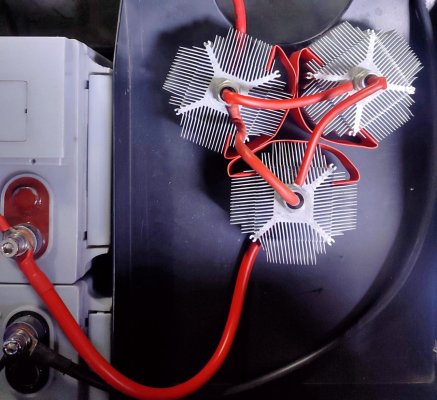
I checked the voltages, and the float voltage did drop down to 54.2V which was excellent. Then I did a load test and it exploded:
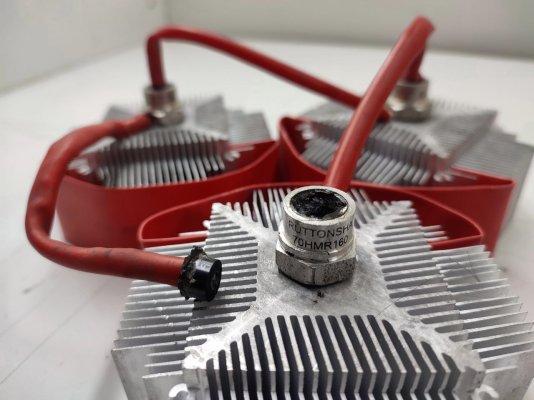
It's rated for 70A, but that's probably for AC. Most people de-rate AC ratings by a factor of 10 for DC, so this was unavoidable. I tried the other diodes I got, thinking this may have been a defective diode but no, they all overheated and failed.
Now, I could bring my enthusiasm for a solution into question and either continue my search to find better diodes and come up with some kind of elaborate solution using a solid state relay or dc switching contactor which would bypass the diode when there's a power cut (thereby preventing the overheating explosions) or — I could even build an external charger for the batteries using Ashapower's Solar MPPT chargers that have configurable charge settings, you could theoretically run them off DC power supplies instead of solar panels but that would probably cost just as much as — going about replacing my inverter with something that's compatible with SMF batteries (charging at 13.5V per battery).
Whichever way I go, I'll update here whenever I go that way, haha.
Previous posts on the topic:
Guide - DIY Wi-Fi Battery Monitor for Inverters/UPS (IoT Lead Acid Battery?)
A Never Ending Back Story: About two and a half years ago, I bought an inverter that needed four batteries running at 48V: https://techenclave.com/threads/wtb-sinewave-ups-inverter-so-need-suggestions.198174/#post-2269678 The inverter was paired with four Amaron Quanta batteries, this was a...
Guide - DIY Lead Acid Battery Tester with Automotive Headlights (and Wi-FI?)
After building the battery monitors and discovering that one of my batteries was essentially dead, I wanted to quantify just how dead it was. The best way appears to be adding a resistive type load of known amperage and calculating battery capacity with those numbers. Starting off: a junction...
One of the earlier warning signs I noticed (and chose to ignore) when I first started trying to understand why my inverter batteries died so quickly (2.5 years) was this:
From: https://www.amaronbatteryinverterchennai.com/files/amaron/Quanta Silver Book.pdf
Float/Standby
This charging method is normally used in applications, such as emergency back-up when the battery is required only upon mains failure, e.g., Alarm panels, emergency lighting. In each case, the battery is continuously on charge and consequently, the recommended voltages are slightly lower than cyclic charging so as not to damage the battery. (Float voltage for Amaron Quanta range = 13.5 V per 12 V module).
And from: https://amaronquanta.com/wp-content/uploads/2022/04/Amaron_OM_Manual.pdf
Do not float batteries at voltages higher or lower than those recommended which will be resulted reduced capacity or loss of battery life.
The inverter I'm using (Luminous Cruze+) floats the batteries at around 13.9V per battery, which sounds like it's a lot higher than what's recommended and may have been a reason why my batteries died so quickly.
The charging/float voltage on this inverter is not configurable and short of reverse engineering/modifying the controller board, I'm not left with any option other than to exchange my sealed batteries for flooded ones.
But I really like these batteries, so I spent several weeks searching the internet and found this somewhat relevant post/reply from twenty (!) years ago:
Does anyone know how to adjust the voltage at which an APC Smart-UPS floats
its batteries? Their factory default at room temperature seems to be about
2.33V/cell, which exceeds the manufacturer-recommended voltages for every
sealed-lead acid battery I've looked up (equivalent to 14.0V on a 12V string).
We've had to replace batteries these UPSes every 2-3 years, on average,
probably as a result of electrolyte loss from the high charging voltage.
Can this be controlled from an attached PC through the serial interface?
APC's tools seem to offer no such option, but I've heard rumors about an
undocumented calibration procedure.
(To answer their original question, the calibration procedure is now well documented elsewhere and here: https://kirbah.github.io/apc-ups/)
It really sounds like they had a very similar problem to mine back then — high float voltage shortening the life of SMF batteries.
A reply stood out:
In the past I have put a diode in series with a charger
This made sense to me, the idea/practice of lowering the float voltage with a diode. So my searchings were renewed for a high power diode and I found these 40A and 70A rated diodes at mathaelectronics.com:

I got a few them and started thinking about how I'd want them wired up. I'd need them to be able to conduct electricity in both directions, so that the inverter can both drain and charge the batteries. And I'd want at least a 1.5V drop during float charge, so as to bring the +55V float voltage down to 54V. A single diode drops voltage by about 0.7V. I came up with this arrangement:

It looks pretty awesome haha, it's basically three diodes arranged in a circle. The idea is that the battery is connected to one diode on the top left, and the inverter to the diode on the top right. So electricity flows through one diode when the inverter is pulling power from the battery, and it flows through two diodes when it's time to charge the batteries.
The heatsinks are old LGA775 ones with a center hold drilled and tapped for M8. I added a some heatshrinking to serve as insulation between the heatsinks. I'm expecting about 30W of heat dissipation at 1000W (1000W/48V is 20A, maximum voltage drop of this diode according to it's datasheet is 1.4V and 1.4V x 20A is 28W).
Here's it installed:

I checked the voltages, and the float voltage did drop down to 54.2V which was excellent. Then I did a load test and it exploded:

It's rated for 70A, but that's probably for AC. Most people de-rate AC ratings by a factor of 10 for DC, so this was unavoidable. I tried the other diodes I got, thinking this may have been a defective diode but no, they all overheated and failed.
Now, I could bring my enthusiasm for a solution into question and either continue my search to find better diodes and come up with some kind of elaborate solution using a solid state relay or dc switching contactor which would bypass the diode when there's a power cut (thereby preventing the overheating explosions) or — I could even build an external charger for the batteries using Ashapower's Solar MPPT chargers that have configurable charge settings, you could theoretically run them off DC power supplies instead of solar panels but that would probably cost just as much as — going about replacing my inverter with something that's compatible with SMF batteries (charging at 13.5V per battery).
Whichever way I go, I'll update here whenever I go that way, haha.
Last edited:



